Introduction: In this article, Gena Philibert-Ortega writes about a possible burial place for your ancestor: the local “potter’s field.” Gena is a genealogist and author of the book “From the Family Kitchen.”
As family historians we focus on tracing our family lineage. One way we do this is to prove our ancestor’s life, starting with their death. Most researchers use two sources for death to find the information they need: a cemetery grave marker and a death certificate.
We’ve discussed in previous blog articles that not everyone’s grave is marked. In some cases, a person is buried in an unmarked grave. This is especially true if their burial is in a potter’s field.
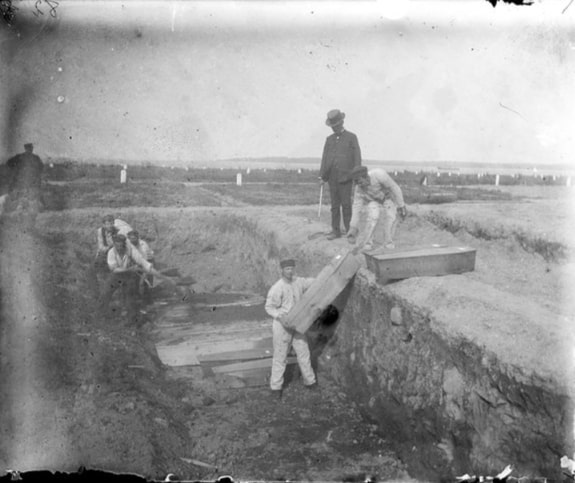
What Is a Potter’s Field?
Before we look at burials in a potter’s field, let’s first define what one is. The name potter’s field comes from the Bible, which refers to a potter’s field as a burial place for foreigners. (1)
According to David Charles Sloan’s book The Last Great Necessity: Cemeteries in American History, prior to the nineteenth century Americans interred the deceased in four types of places:
“The earliest burials were by pioneers in unorganized isolated places. As the population grew, settlers became more formal in honoring their dead. A burial place situated on a family farm might also be for neighboring families. Next, churchyards were established…”
He goes on to write that “most towns maintained a potter’s field.” Potter’s fields were usually a plot or section set aside in a community or church graveyard for indigent burials.” (2) Unfortunately, over time “Potter’s fields were transient places and were often abandoned…” (3)
One of the problems with accessing the place where these burials occurred has to do with their lack of longevity and identification. Some, having been abandoned with no individual grave markers, could easily be forgotten over time. Because the burials are not marked, it can also be difficult to identify where a loved one was potentially buried.
Who is buried in a potter’s field? There are several conditions that can result in a person being buried in a potter’s field. They include those who are not identified (such as those from outside of a community that were traveling through or working), and recent immigrants. Identified people also get buried in a potter’s field if: the family doesn’t come forward to claim the body for burial; the person was impoverished and left no money for their burial; people who died in an epidemic; or people who were institutionalized, such as in prison.
Potter’s Fields Mentioned in Historical Newspapers
Historical newspaper articles referring to potter’s fields help us better understand their place in the history of burial in the United States. Browsing your ancestor’s hometown newspaper can help you understand where potter’s fields were located, and if a family burial could be found in a potter’s field.
As mentioned previously, unidentified people were buried in potter’s fields. In the case of this 1905 man, a photo was taken by the coroner in case an identification could be made later. Though it’s possible that some people would have been identified and later exhumed for reburial, in some cases it would have been impossible.
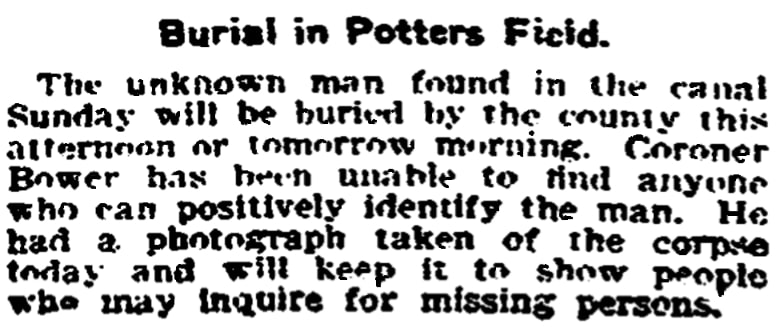
This 1921 newspaper article tells the story of Private William Ausman, who fell from a building in Los Angeles. His dog tags identified him and the local American Legion insisted he not be buried in a potter’s field. Presumably, this option was being considered because of his lack of funds and/or the inability to contact family. Further investigation by the American Legion found that other World War I soldiers who died “friendless and penniless” were buried in potter’s fields.
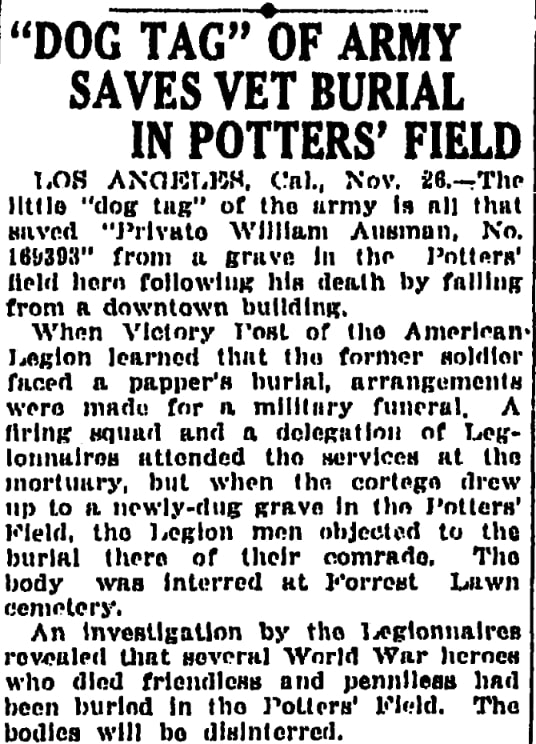
As is apparent from the previous newspaper article, it’s not just the unidentified who are buried in potter’s fields. Those who have no money or whose family don’t care to step forward to claim the body for burial can be found there.
This example from 1909 tells the story of John B. Varano and the “demon drink.” Despite having a wife and close relatives, he was buried in a potter’s field:
“Deserted by friends and relatives alike, doubtless his own fault caused by his craze for drink, Varano was laid away today without a single mourner following his remains, and without a flower to mark his new-made grave and show that some one still remembered him.”
Luckily for the genealogist who is related to him, although there is likely no grave marker for him in the potter’s field, historical newspapers still document his story.

Epidemics can also be a cause for unmarked burial in a potter’s field. Consider this New York example reported in 1832. The potter’s field is said to be:
“…four miles from the centre of the city, contains from fifteen to eighteen acres, beneath the surface of which 20,000 remnants of mortality have been deposited within the last seven years.”
Cholera caused the burials to skyrocket to 100 a day, according to the article. Trenches were used to “layer” bodies until they were only three feet below the surface. The article ended with mentioning that “hardly a dozen grave stones” exist in the field. In the case of an epidemic or a disaster, overwhelmed funeral homes or communities may need to quickly bury those who have passed away.
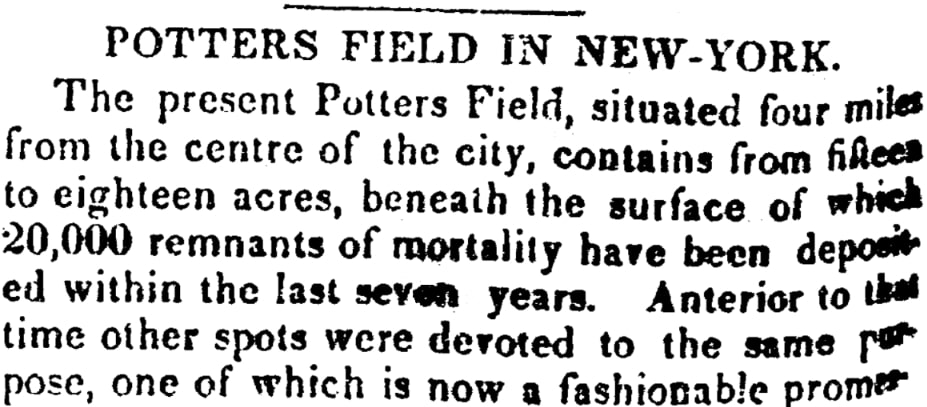
Try Historical Newspapers
One of the lessons I learned from studying historical newspaper articles about potter’s fields is how much information was provided in newspapers for those that were laid to rest in unmarked graves.
For example, this 1897 Dallas, Texas, newspaper article is about Anna Shaw. The article detailed her age, where she died, her last acts, her funeral, where it was held, and reported that she was buried in a potter’s field. While it is true that not everyone has an obituary to mark their death, newspapers can hold surprises.
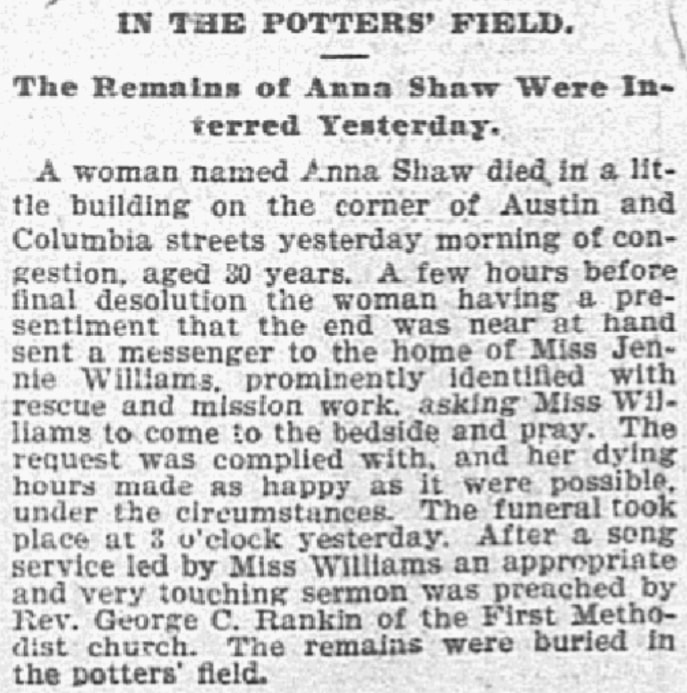
Potter’s fields still exist and are home to burials today as they were in the past. In some cases, the unclaimed or indigent are cremated and scattered at a cemetery, while others are buried. New York City’s Hart Island is a century-old potter’s field that saw an influx of burials during the AIDS crisis due to funeral homes not accepting those who died of AIDS for burial. (4) Over a million people are buried there and 1,100 burials still occur each year. (5)
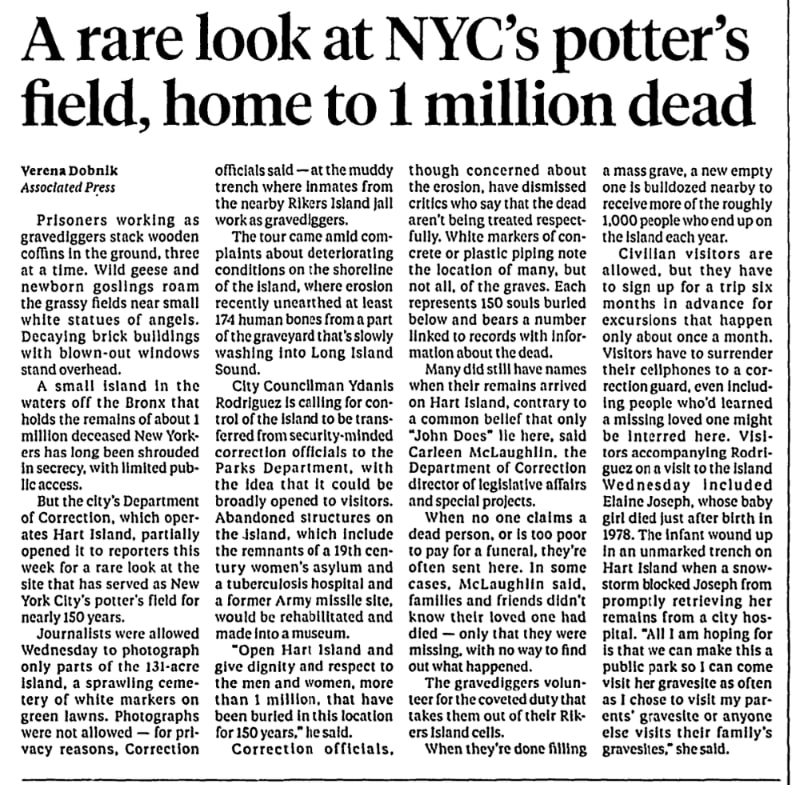
If your ancestor died impoverished, unknown, unclaimed, or during an epidemic/disaster, it’s possible they were buried in a potter’s field. Unfortunately, those records may not exist. Consult the death certificate, when applicable, for any notes of the burial place. Don’t forget to also consult historical newspapers, such as GenealogyBank’s Historical Newspaper Archives. Don’t just look for an obituary. Search for their name or the words “potter’s field.”
Explore over 330 years of newspapers and historical records in GenealogyBank. Discover your family story! Start a 7-Day Free Trial
Note on the header image: potter’s field graves in Dunn County, Wisconsin. Credit: Bstaab22; Wikimedia Commons.
Related Articles:
- It’s Not All Online: Cemetery Research
- Cemetery Language: A Glossary for Genealogists
- Cemetery Etiquette for Genealogists
- Genealogy Tips: Not Every Burial Can Be Found
________________________
(1) Matthew 27:7
(2) Sloan, David Charles. “The Last Great Necessity: Cemeteries in American History.” Baltimore: The Johns Hopkins University Press, p. 24.
(3) Sloan, David Charles. “The Last Great Necessity: Cemeteries in American History.” Baltimore: The Johns Hopkins University Press, pp. 13-14
(4) “Land of the Unknown: A History of Hart Island.” (https://www.nypl.org/blog/2021/01/07/land-unknown-history-hart-island: accessed 1 November 2023).
(5) “A Million Bodies Are Buried Here. Now It’s Becoming a Park.” New York Times (https://www.nytimes.com/2023/03/24/nyregion/hart-island-cemetery-park.html: accessed 1 November 2023).

I have been fortunate enough to find a number of relatives and even a few ancestors in the Columbus, Georgia, area, circa late 19th, early 20th centuries. The sexton of the largest local cemetery kept very good records which have been saved and transcribed. Much of the information is only vaguely usable such as “A child of Jane Smith, age 6 months, was buried on March 1, 1881, in the old section. Grave was not identifiably marked.” At least we know that such a child existed and have reasonably accurate birth and death dates. (The name and date I used here are NOT real.)
Joe, I agree. Even without specifics as to the actual burial place, the clues that can be had on the records about the very existence of a person are vital.
Thanks for sharing your experience with us. I appreciate it.